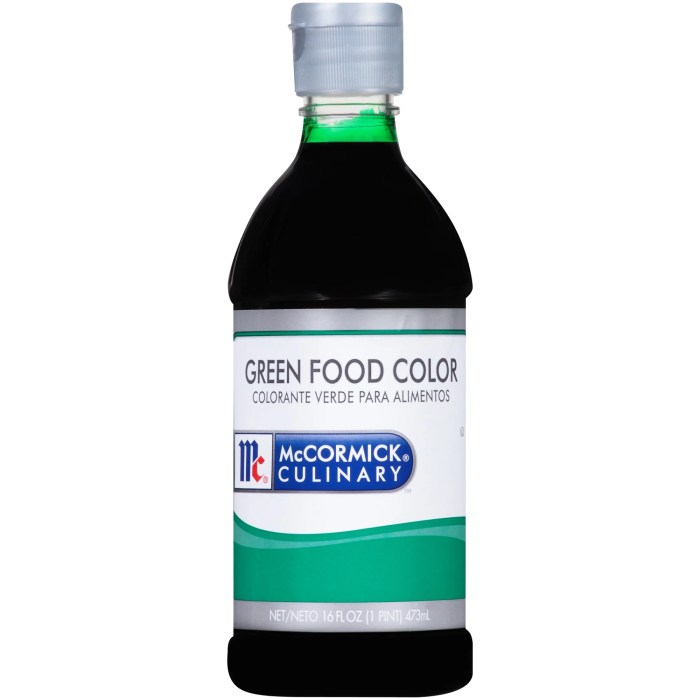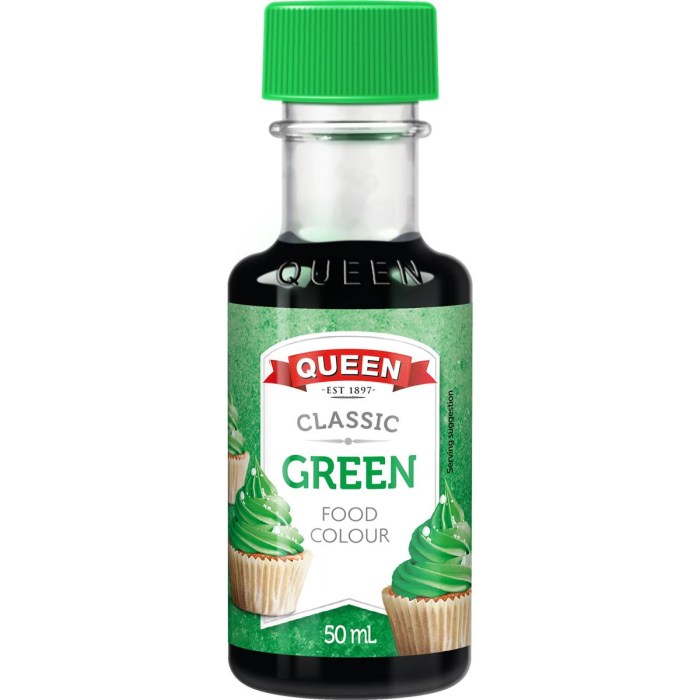Chemical Composition of Green Food Coloring: Green Food Coloring Number

Green food coloring number – Yo, what’s up, food coloring fanatics! Let’s dive into the surprisingly complex world of green food coloring. Think it’s just a simple splash of green? Think again. It’s a chemical rollercoaster, my friends, a vibrant ride through synthetic and natural compounds. Buckle up!
Green food coloring, whether it’s that neon green in your Gatorade or the more subtle hue in your spinach-infused smoothie, comes in a variety of forms, each with its own unique chemical makeup. The differences are significant, impacting not only the shade of green you get but also its stability and potential health implications (though generally, food coloring is deemed safe at regulated levels).
We’re talking about a whole spectrum, from the bright, almost radioactive, to the more subdued, natural tones.
Chemical Components of Green Food Colorings
The chemical composition varies wildly depending on whether we’re talking about natural or artificial green food coloring. Artificial colors are typically synthetic organic compounds, often complex mixtures designed to achieve specific shades and stabilities. Natural colorings, on the other hand, are derived from plants or other natural sources, resulting in a more diverse and often less predictable chemical profile.
Artificial green food colorings often utilize a combination of yellow and blue dyes. For example, a common combination might include Yellow 5 (tartrazine) and Blue 1 (brilliant blue FCF) or other similar dyes. The precise ratios of these components determine the final shade of green. Natural green food colorings might use chlorophyll (from plants like spinach or kale), spirulina extract, or other plant-based pigments.
These natural sources offer a less uniform color range compared to their artificial counterparts, often presenting variations depending on the plant’s growing conditions.
Structural Differences Between Natural and Artificial Green Food Colorings
The structural differences are fundamental. Artificial dyes are usually small, relatively simple molecules with conjugated double bonds that give them their vibrant color. These molecules are designed for stability and ease of manufacturing. Natural pigments, conversely, are often much more complex macromolecules with varied structures and functional groups. Chlorophyll, for instance, is a porphyrin ring complex containing a magnesium ion at its center – a far cry from the simpler structure of a synthetic dye.
This complexity in natural pigments contributes to their often less intense and more muted color compared to artificial counterparts. Think of it like this: artificial food coloring is a perfectly tuned sports car; natural coloring is a classic, handcrafted wooden sailboat. Both get you where you need to go, but in very different ways.
Stability of Green Food Colorings, Green food coloring number
The stability of green food coloring is influenced by factors like light, heat, and pH. Artificial dyes generally exhibit better stability than natural pigments. Exposure to intense light can cause fading or color changes in both types, but natural pigments are usually more susceptible. Similarly, heat can degrade both, but natural pigments tend to be more sensitive.
The vibrant hue of green food coloring number 3, often found in candies and baked goods, derives from a complex chemical structure. Its intense color makes it a popular choice for many culinary applications, including, surprisingly, egg dye with food coloring , where its intensity can create strikingly bright Easter eggs. Ultimately, the versatility of green food coloring number 3 extends far beyond simple confectionery.
pH also plays a role; some artificial and natural green dyes are more stable within a specific pH range.
For example, chlorophyll is known to degrade more rapidly in acidic conditions, leading to a change in color. This is why you might see your green smoothie lose some of its vibrancy over time. Artificial dyes, while more stable, can still be affected by extreme pH levels, potentially leading to a slight shift in hue.
Summary Table of Common Green Food Colorings
Here’s a quick rundown of some common green food colorings, highlighting their key characteristics:
| Food Coloring | Type | Chemical Composition | Stability |
|---|---|---|---|
| Brilliant Green | Artificial | Sulfonated triphenylmethane dye | Moderate; susceptible to light and heat |
| Fast Green FCF | Artificial | Triarylmethane dye | Good; relatively stable under various conditions |
| Chlorophyll | Natural | Porphyrin complex with magnesium ion | Low; sensitive to light, heat, and pH changes |
| Spirulina Extract | Natural | Phycocyanin and other pigments | Moderate; more stable than chlorophyll but still affected by light and heat |
Manufacturing Process of Green Food Coloring

So, you think green food coloring just magically appears in your supermarket? Think again, my friend. It’s a surprisingly complex process, a bit like making a potion, but instead of turning frogs into princes, we’re turning chemicals into vibrant shades of green. Let’s dive into the surprisingly fascinating world of artificial green food coloring production.
Raw Material Sourcing
The creation of artificial green food coloring begins with the sourcing of raw materials. These aren’t your grandma’s garden herbs; we’re talking about specific chemicals, often petroleum-derived, that are carefully selected for their purity and suitability for food applications. Key ingredients frequently include petroleum-based aromatic compounds, which undergo various chemical reactions to create the desired colorants. The purity of these starting materials is crucial; any impurities can affect the final product’s color, stability, and, importantly, safety.
Suppliers undergo rigorous audits to ensure consistency and quality. Think of it like choosing the freshest ingredients for a gourmet meal – except instead of tomatoes and basil, we’re dealing with complex organic compounds.
Synthesis and Chemical Reactions
Once the raw materials are secured, the actual synthesis begins. This is where the magic (or, let’s be honest, the chemistry) really happens. Multiple chemical reactions are carefully controlled to create the specific green pigments. These reactions might involve processes like diazotization, coupling, and sulfonation – technical terms, I know, but essentially, it’s all about manipulating molecules to achieve the precise shade of green required.
Temperature, pressure, and reaction time are meticulously monitored to ensure consistency and prevent unwanted byproducts. It’s like a highly precise recipe, followed to the letter to avoid any culinary disasters (or in this case, a batch of off-color food coloring).
Purification and Standardization
After synthesis, the resulting green pigment isn’t quite ready for your cupcakes. It needs further purification to remove any impurities or unwanted byproducts formed during the chemical reactions. This often involves techniques like filtration, crystallization, and drying. The purified pigment is then standardized to ensure it meets the required specifications for color strength, purity, and stability. Think of this stage as polishing a gemstone – removing any imperfections to reveal its true brilliance.
Strict quality control measures are implemented at this stage to ensure the product meets regulatory standards.
Formulation and Packaging
The purified and standardized green pigment is then formulated into a usable form. This often involves mixing it with other ingredients like water, solvents, or stabilizers to improve its solubility, shelf life, and overall performance in food applications. The final product is then packaged according to industry standards, often in liquid or powder form, ready for use by food manufacturers.
This final step is crucial for maintaining the product’s quality and preventing degradation during transportation and storage.
Quality Control Measures
Throughout the entire manufacturing process, rigorous quality control measures are in place. Samples are taken at various stages, and rigorous testing is conducted to ensure the color meets specific standards for purity, strength, and stability. This includes tests for heavy metals, microbial contamination, and other potential hazards. Imagine a team of highly trained food color inspectors, meticulously examining every step of the process, ensuring that only the best and safest green coloring reaches the market.
Non-compliance at any stage leads to rejection of the batch, emphasizing the importance of this rigorous process.
Flowchart: Manufacturing of Tartrazine-Based Green Food Coloring
Imagine a flowchart with boxes connected by arrows.Box 1: Raw Material Sourcing (Petroleum-derived aromatic compounds, etc.)Arrow to Box 2: Synthesis (Diazotization, coupling, sulfonation reactions)Arrow to Box 3: Purification (Filtration, crystallization, drying)Arrow to Box 4: Standardization (Color strength, purity, stability testing)Arrow to Box 5: Formulation (Mixing with water, solvents, stabilizers)Arrow to Box 6: Packaging (Liquid or powder form)Arrow to Box 7: Quality Control (Testing at each stage for purity, heavy metals, etc.)
Question Bank
What are the most common natural sources of green food coloring?
Spinach, chlorophyll, spirulina, and matcha are among the most common natural sources, each offering slightly different shades and intensities of green.
Are all green food colorings created equal?
No, artificial and natural green food colorings differ significantly in their chemical composition, stability, and potential health effects. Natural options generally are considered safer but might be less vibrant or stable.
Is there a risk of allergic reactions to green food coloring?
While rare, allergic reactions are possible, particularly with certain artificial dyes. Always check food labels and consult with a doctor if you have concerns.
How is the safety of green food coloring regulated?
Regulatory bodies like the FDA (in the US) and the EFSA (in Europe) set acceptable daily intake (ADI) levels and monitor the safety of food colorings, ensuring they meet stringent standards.
